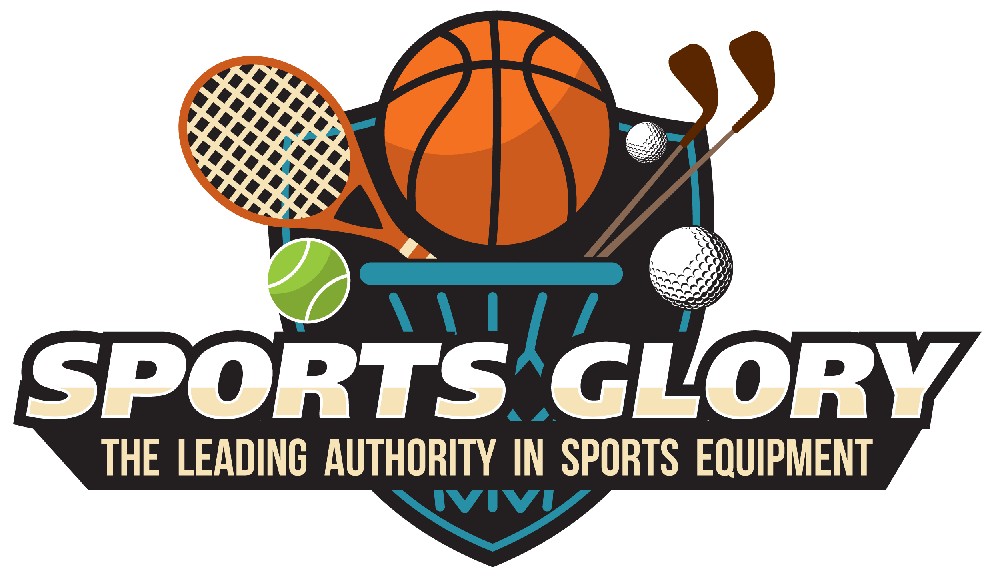It’s incredible how something as simple as picking up heavy stuff can be one of the most rewarding experiences in life. Whether you lift weights to chisel your body or for the pure ecstasy of putting up big numbers, a lifting belt might help you achieve your goals faster by helping align your body.
Lifting belts, also called back braces, ab belts, and lumbosacral support belts, are wide, thick belts that are worn around the abdomen near the belly button area. They provide support and stability to your spine by allowing you to brace your abdominals against the lifting belt, increasing intra-abdominal pressure to stabilize your core. This can aid lifters in lifting heavier weights and increasing their rep ranges as well as help prevent injury.
We have put together this resource to teach you the basics of lifting belts and provide you with a list of the best belts on the market. Let’s warm up by going over the key aspects of a lifting belt.
Contents
- What to Look for in a Lifting Belt
- The 10 Best Lifting Belts in 2024
- 1. Best Overall Lifting Belt: Dark Iron Fitness Pro Lifting Belt
- 2. Best Premium Lifting Belt: Iron Bull Strength Weight Lifting Belt
- 3. Best Budget Lifting Belt: Harbinger 4” Nylon Weightlifting Belt
- 4. ProFitness Leather Lifting Belt
- 5. Best Padded Lifting Belt: Bear KompleX 6” Lifting Belt
- 6. Best Crossfit Lifting Belt: Element 26 Self-Locking Lifting Belt
- 7. Most Flexible Lifting Belt: Harbinger 5” Flexible Weightlifting Belt
- 8. RDX Powerlifting Belt
- 9. Most Comfortable Lifting Belt: Steel Sweat Nylon Lifting Belt
- 10. Harbinger Padded Weightlifting Belt
- Buying the Best Lifting Belt
- Bottom Line
What to Look for in a Lifting Belt
There are a surprising number of aspects to a lifting belt that will dictate which one is best for you. The primary things to pay attention to when hunting for a lifting belt are the materials it’s made from, the lifting belt’s dimensions, and its closure system.
Lifting Belt Closure Systems
There are three primary lifting belt closure systems: levers, Velcro, and pronged closures like the kind you find on standard belts but with additional prongs (often two) due to the width of the belt. Each closure system has its merits, and this generally comes down to preference.
In short, levers and Velcro are quick and easy to strap in or loosen while prong closure systems are typically less expensive but still get the job done well. Check out our buyer’s guide at the bottom for more detailed explanations.
Lifting Belt Materials
In general, lifting belts are either made from leather or nylon. Thick leather is the classic and most common material thanks to its ability to provide great rigidity while still being flexible enough to offer comfort during use. The primary drawbacks of leather are its higher cost, heavier weight, and bulkier form that can inhibit mobility and make it a general pain to lug around.
Nylon, on the other hand, is much lighter, more flexible, and less expensive. The downside of this is the increased flexibility of the material means it can provide less assistance in increasing intra-abdominal pressure (IAP) which may result in reduced performance benefits compared to rigid leather lifting belts.
Lifting Belt Dimensions
Lifting belts can come in a variety of shapes and sizes that offer various benefits and drawbacks. The standard width of a lifting belt is between 4 to 6 inches with 4 inches being the standard used by most belts. The thickness of the belt is also a consideration as thicker material means more stability but less mobility.
The shape of a lifting belt can vary between standard belts that have a uniform width along the belt and tapered belts that are wider in the midsection while being narrower on the sides to strike a balance between support and mobility.
Competition Approval
All kinds of lifters test their mettle (and PRs) at official competitions. If you’re interested in participating in competitions and performing lifts that require lifting belts, consider purchasing one that’s approved by an official governing body.
Now, let’s strap in and get to the list.
The 10 Best Lifting Belts in 2024
1. Best Overall Lifting Belt: Dark Iron Fitness Pro Lifting Belt
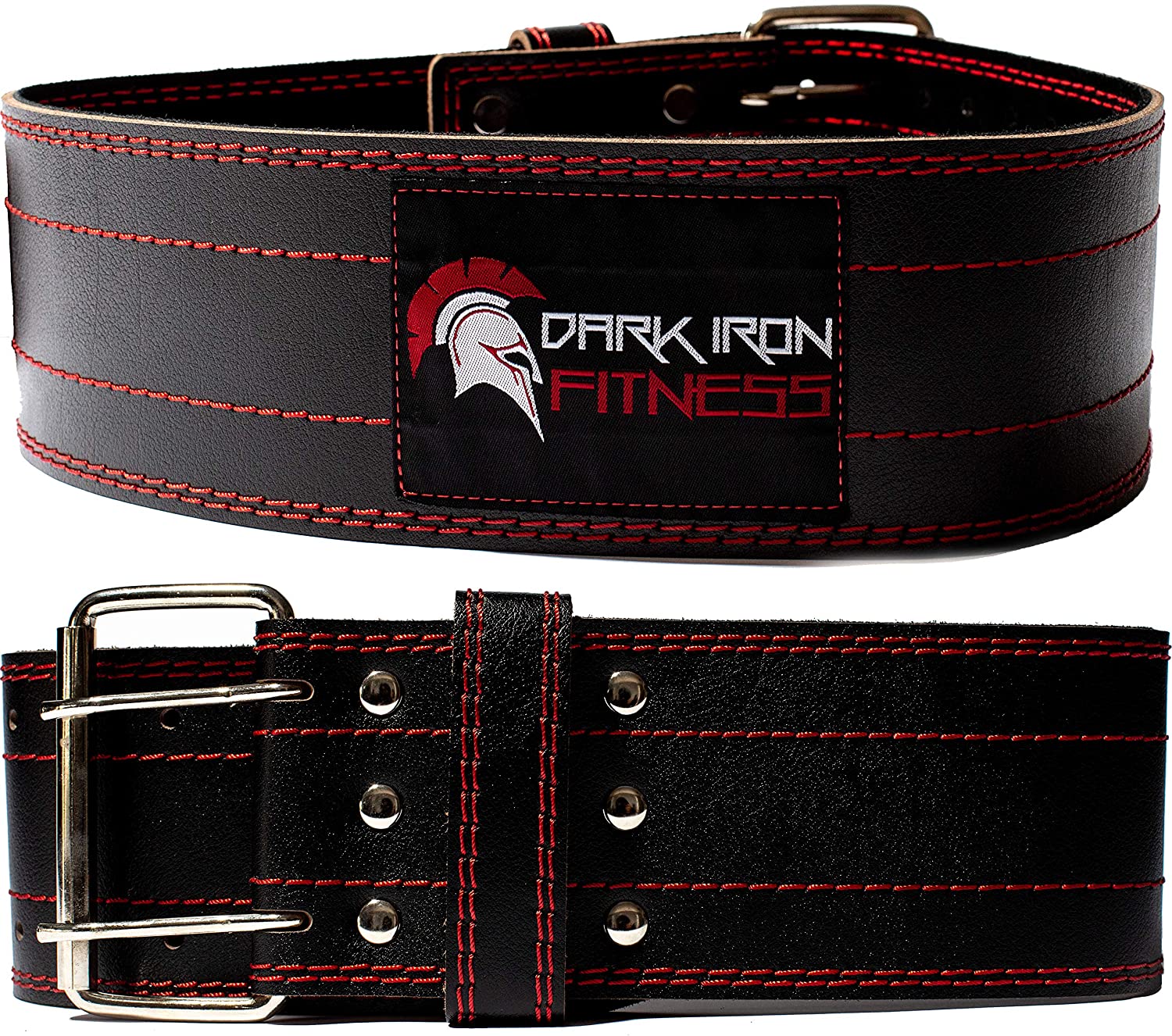
Editor’s Rating:
Quick Facts
- Closure: Two-prong
- Material: Leather
- Width: 4”
- Competition Approved: Yes
Overview
This standard two-pronged closure, 4” wide lifting belt is a no-frills offering that keeps things simple and effective. The leather is soft yet solid to provide an excellent combination of comfort and supportive structure throughout your lifts. The black leather with red stitching offers a classic, attractive look that won’t make you stick out like a sore thumb. However, a lack of customization options is a small downside.
As with all leather lifting belts, the Dark Iron Fitness belt will have a brief breaking-in period when the leather is more rigid than flexible. After this belt is completely broken in, the comfort, flexibility, and support it provides are incredible—especially at this low of an asking price.
Quality
This Dark Iron Fitness lifting belt uses quality materials and build construction throughout to provide excellent support and stability that doesn’t pinch or bind. The leather is firm yet supple and offers great comfort and core support. The double stitching is rugged and tidy, making this lifting belt a reliable piece of sports equipment that should last you for many years to come.
In fact, Dark Iron Fitness is so confident in the quality of their belts that they offer a customer satisfaction guarantee. They’ll send you a brand new belt at no cost if your lifting belt ever fails. That’s pretty impressive for any product, but is especially impressive for a lifting belt that is already very affordable.
Who It’s Best For
If you have no idea what to look for in a lifting belt, just get this one. Built for the specific purpose of providing excellent stability and comfort while being able to stand the test of time, the Dark Iron Fitness lifting belt is an easy recommendation for lifters that want to stack on the plates without breaking their back or their bank.
If you don’t care about having an approved competitive lifting belt, this ProFitness lifting belt on our list is very similar to the Dark Iron Fitness belt but offered at a slightly lower cost with the primary difference being that the ProFitness belt is not approved for competitive lifting events.
- Superior quality of materials and construction
- Exceptional cost to performance ratio
- Approved for IPF and USAPL competition
- Customer satisfaction guarantee offers free replacement if belt ever fails
- Only comes in one style/color
2. Best Premium Lifting Belt: Iron Bull Strength Weight Lifting Belt
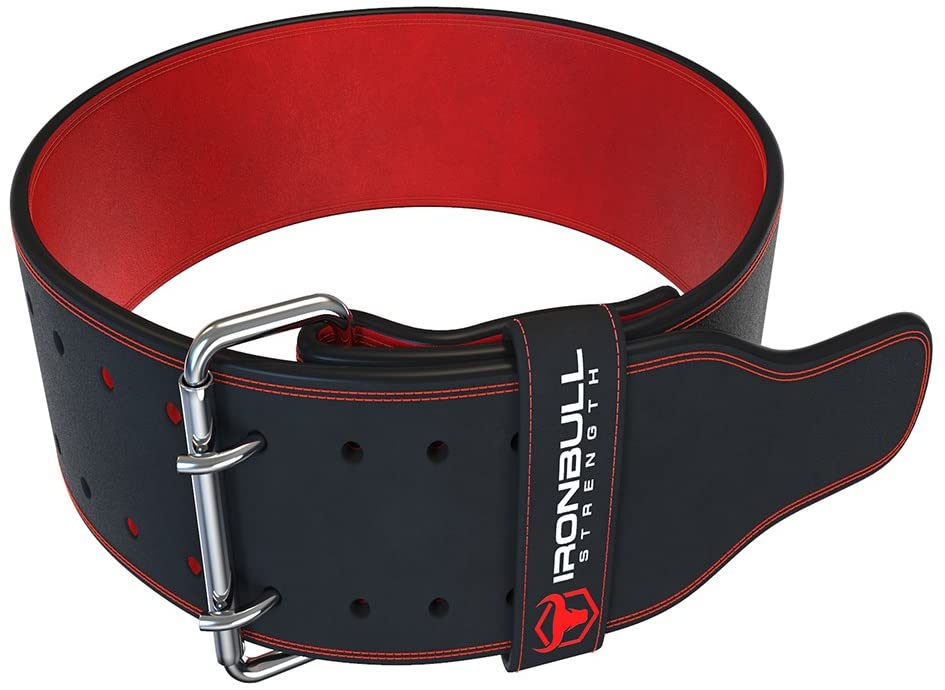
Editor’s Rating:
Quick Facts
- Closure: Two-prong
- Material: Leather
- Width: 4”
- Competition Approved: Yes
Overview
The Iron Bull Strength weight lifting belt is built to withstand the tests of time and pressure alike. At a standard 4 inch thickness, this powerlifting belt offers excellent coverage and even distribution of force to provide enhanced core stability that doesn’t pinch or inhibit good form. The two-prong closure system is fairly standard and offers lifters a decent amount of flexibility for dialing in a snug fit quickly.
The thick leather offers excellent stability thanks to the material’s ability to balance rigidity and malleability in equal measures. Like a solid pair of boots, leather construction like this can take some time to break in. As such, this lifting belt is likely to be a bit uncomfortable for the first few workouts until it loosens up and conforms to your body.
Quality
The Iron Bull Strength powerlifting belt is made from premium 10mm thick suede leather held together with immaculate double-stitching. The two-pronged buckle is also built to last with its zinc-plated steel construction. Not only is the Iron Bull Strength lifting belt a powerful piece of craftsmanship, it also comes in a variety of bold, striking color options so you can pick the style that best suits your tastes.
Some reviewers have complained of receiving this belt with some rusting on the metal components, but the majority seem to have no issues regarding this complaint. Overall, the build quality and materials are well worth the asking price, with other bigger-named brands offering similar quality at a considerably higher price point.
Who It’s Best For
This lifting belt is a solid recommendation for serious lifters who like firm, structured support. The thick leather offers a dense yet supple bracing that offers great compression with slight flexibility to allow the belt to remain snug throughout your movements. The price on this makes it hard to recommend to beginners who haven’t fully committed to stacking the plates on just yet.
- Premium leather construction
- Approved for IPF and USAPL competition
- Available in a wide variety of colors
- Some complaints of quality control issues
- Pricier than most lifting belts on our list
3. Best Budget Lifting Belt: Harbinger 4” Nylon Weightlifting Belt
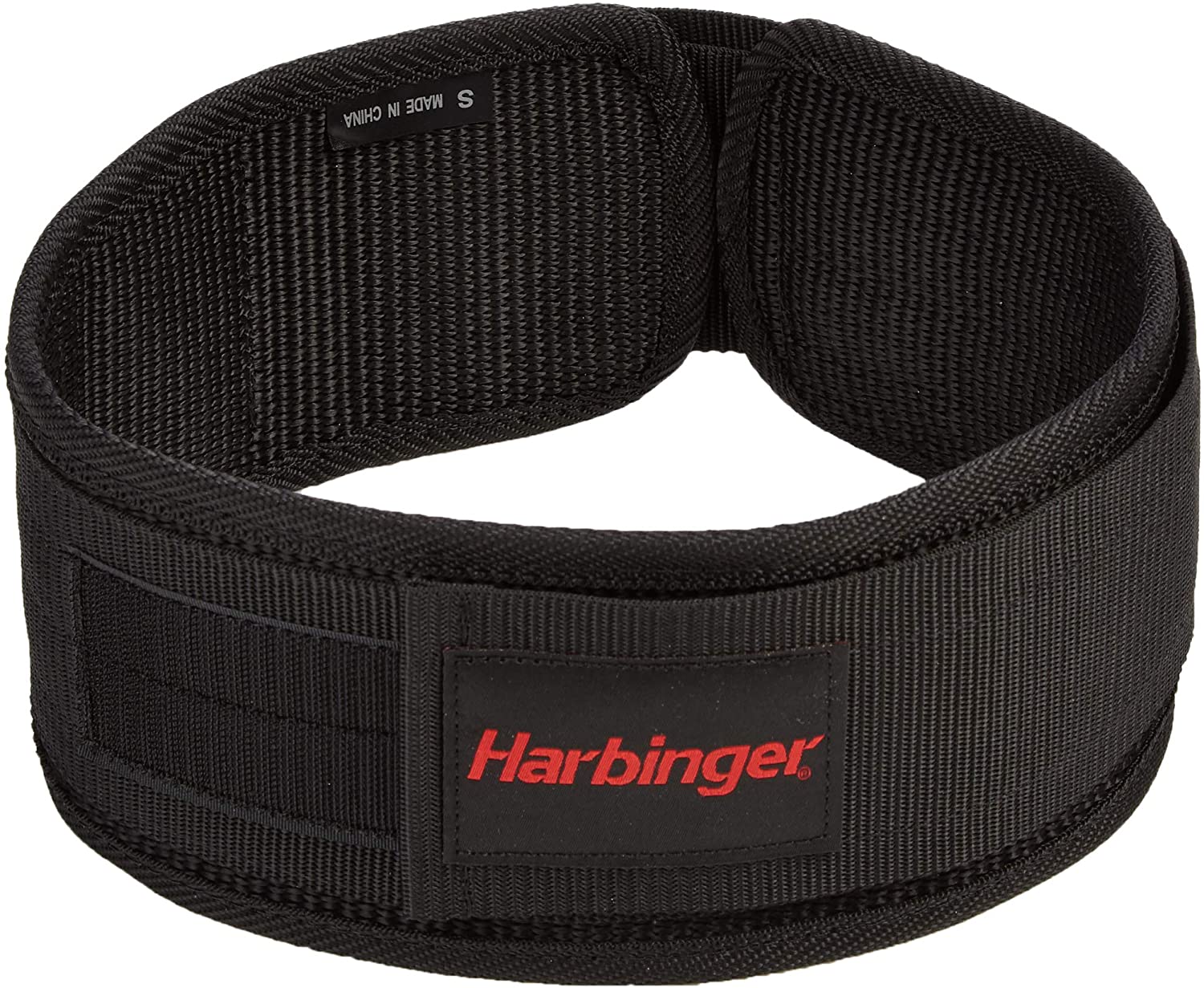
Editor’s Rating:
Quick Facts
- Closure: Velcro
- Material: Nylon
- Width: 4”
- Competition Approved: No
Overview
The Harbinger Nylon Weightlifting Belt is proof that keeping it simple can lead to great results. This lightweight lifting belt uses a Velcro closure system that is super quick and easy to tighten or release on the fly. The steel roller buckle allows for lifters to dial in their desired amount of tension with ease. This entry-level lifting belt is great for lifters who aren’t sure whether they’ll like using a belt or not thanks to its simplicity and low cost.
Quality
The old saying “you get what you pay for” holds true with this belt in the best way possible. While its low cost does mean it’s not the best belt on our list in terms of performance, the price also means Harbinger had to keep things simple when designing this lifting belt. But it’s not so cheap that it’s going to fall apart on you either.
The nylon construction is rugged and built to last, and the steel roller buckle offers solid tension throughout your lifts. The Velcro closure provides great fastening security, but that does come with some drawbacks. However, this Velcro closure system is surprisingly sturdy and shouldn’t cause any issues for new lifters giving lifting belts a try.
Who It’s Best For
This is an easy buy for lifters that want to give lifting belts a try without dropping too much cash up front. The simplicity of how it operates makes it an even easier recommendation for lifting belt newbies. The lightweight nylon construction makes this a great belt for people who want to focus on mobility, but the lack of solid support is unideal for lifters interested in setting new single rep records.
- Lightweight sturdy construction
- Easy to tighten and release
- Incredibly affordable
- Not competition approved
- Velcro wears out over time
4. ProFitness Leather Lifting Belt
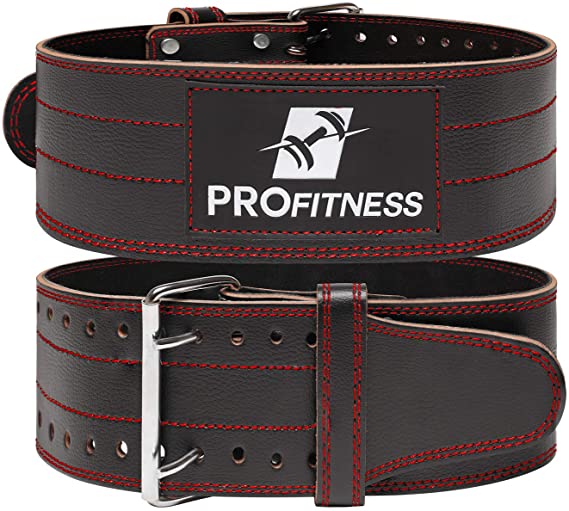
Editor’s Rating:
Quick Facts
- Closure: Two-prong
- Material: Leather
- Width: 4”
- Competition Approved: No
Overview
With genuine 5mm-thick leather, the ProFitness weightlifting belt offers great stability and comfort. Using a standard two-prong closure system, the ProFitness leather lifting belt is easy to use. It’s also built to last with sturdy double-stitching used throughout and steel rivets to hold everything in place. The thick, supple leather provides excellent core support while being pliable enough to remain comfortable throughout your lifts.
ProFitness has had some issues with the rivets on lifting belts popping under heavy load, but this issue seems to only occur rarely with the overwhelming majority of users being extremely impressed by the quality of this belt.
Quality
The ProFitness leather lifting belt is surprisingly well-made—especially considering its low cost. It’s constructed from genuine cowhide leather with slip-resistant suede that keeps the belt in place during lifts. This lifting belt comes with a 60-day satisfaction guarantee so you can return it for a full refund if you’re not happy with the product during your first two months of use. Additionally, the ProFitness leather lifting belt comes with a lifetime warranty that must be registered within the first 7 days of receiving the product.
Who It’s Best For
The ProFitness leather lifting belt is a great lifting belt offered at a great price. When you combine the quality of this belt with its low cost and an excellent warranty, you get a great product that buyers can purchase worry-free. This lifting belt is available with either white stitching or red stitching, offering slight customization.
This belt is very similar to the Dark Iron Fitness belt on our list with the primary difference being that the ProFitness belt isn’t competition approved. This is the only real reason this belt doesn’t top our list. If you aren’t worried about competing, this belt is a great option.
- High-quality materials and construction
- Great price
- 60-day full refund return policy
- Not approved for competitive lifting events
5. Best Padded Lifting Belt: Bear KompleX 6” Lifting Belt
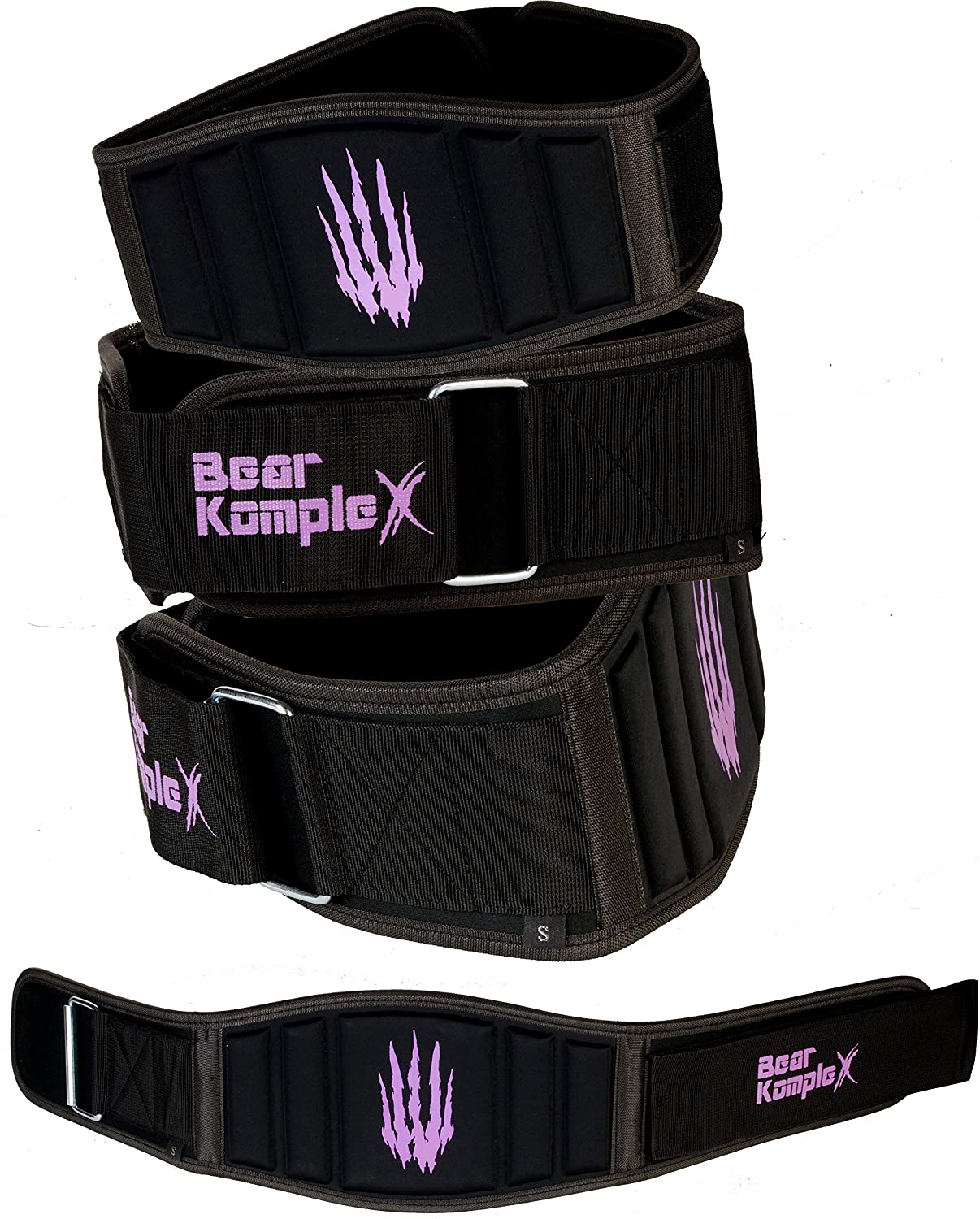
Editor’s Rating:
Quick Facts
- Closure: Velcro
- Material: Nylon
- Width: 6”
- Competition Approved: No
Overview
This Bear KompleX 6” lifting belt is one of the few nylon belts on our list. The padded nylon construction and tapered design provide strong back support that holds firm under pressure without pinching or binding. This lifting belt isn’t approved for competitive lifting, but that doesn’t stop it from providing firm back support throughout your lifts and movements.
The 6” width and tapered design provide extra coverage in the small of the back to provide additional support compared to standard belts. This does come with a slight tradeoff in terms of mobility for some movements. This belt uses a Velcro closure system to make getting in and out of it easy. The major downside of using Velcro as a fastener is that it can lose its adhesive strength over time, but this Bear KompleX belt holds up to frequent use quite well.
Quality
Made from rugged nylon with a steel roller for cinching in the perfect fit, this Bear KompleX 6” lifting belt is built to last. The material balances strength and weight well to provide a solid base of support for your back without having to lug around the added weight of heavier leather belts.
While the fact that Velcro wears out over time is inescapable, the product used on the Bear KompleX lifting belts offers solid adhesion to prevent the belt from loosening or popping during lifts. You can give this belt a try without any worries thanks to the Bear KompleX 60-day satisfaction guarantee. Their guarantee allows you to return your item for any reason during the first 60 days to receive a full refund.
Who It’s Best For
The Bear KompleX 6” lifting belt offers firmer back support than many of the other belts on our list which makes it ideal for people whose backs need some extra support during lifts. Thanks to its padded design and lightweight nature, this belt is a good option for people who are looking for a back brace they can wear while at work or doing chores around the house.
This is a sturdy belt offered at a reasonable price with three style options to choose from. While the Velcro will eventually lose its adhesive strength, this belt should last serious lifters and regular users for over a year of regular lifting.
- Extra-firm back support
- Lightweight and rugged
- Easy to adjust on the fly
- 60-day refund policy
- Velcro will wear out over time
- Not competition approved
6. Best Crossfit Lifting Belt: Element 26 Self-Locking Lifting Belt
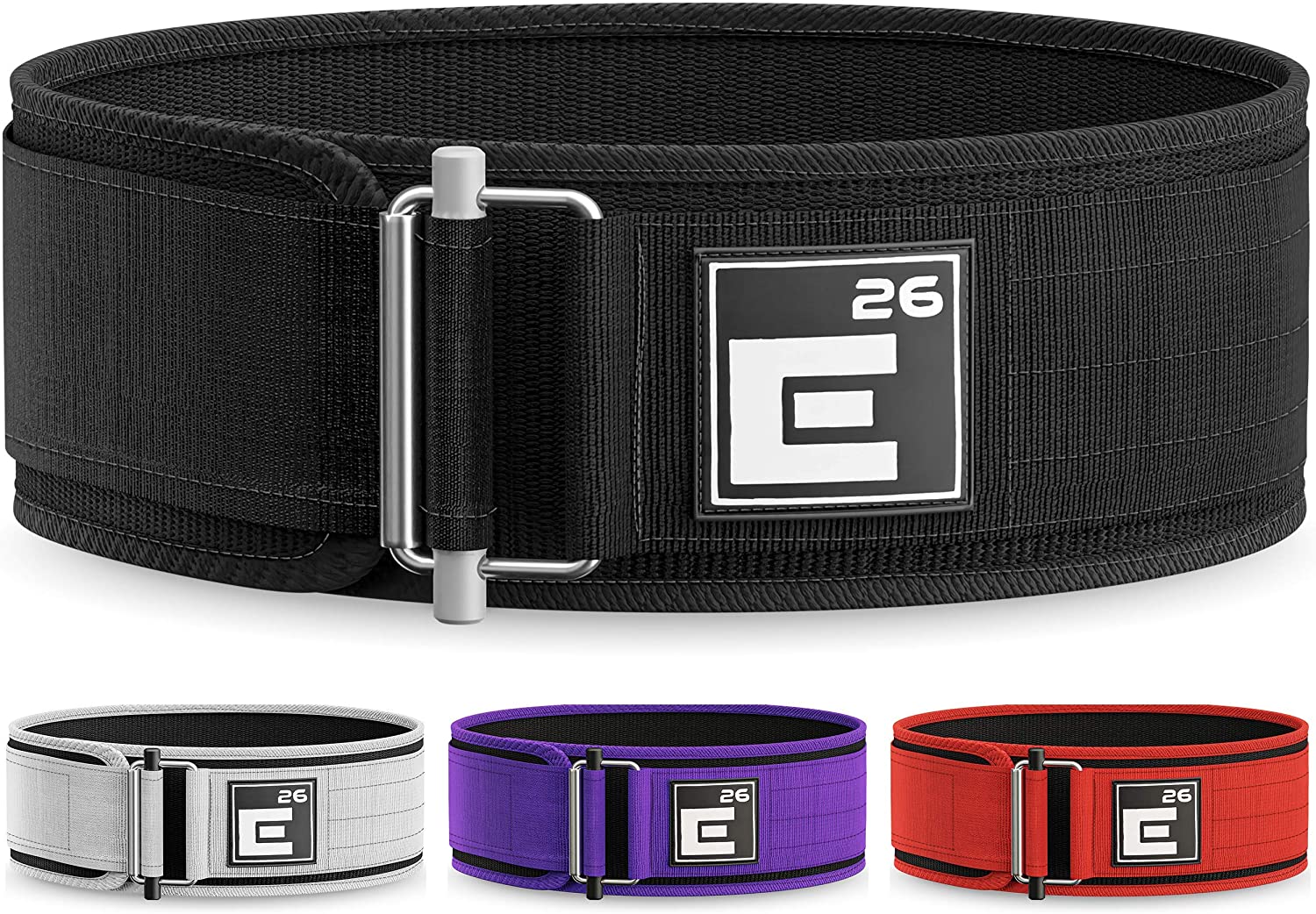
Editor’s Rating:
Quick Facts
- Closure: Self-locking buckle
- Material: Nylon
- Width: 4”
- Competition Approved: *Yes
Overview
The Element 26 lifting belt was built specifically with Crossfit and circuit-style training in mind. Designed to be lightweight, flexible, and quick to release or tighten, this lifting belt is perfect for athletes interested in keeping their workout tempo up. Element 26 provides a lifetime warranty on their belts so you can trust that the product is built to last. This belt also comes in four attractive color options so you can pick the style that best matches your personality.
Quality
The Element 26 lifting belt boasts quality materials and solid construction to provide lifters with the added security and stability they need for putting up big numbers. This lifting belt offers a unique closure system different from most of the other belts on the market. The self-locking closure system is ideal for lifters who like to cinch in to an exact amount of pressure, unlike with pronged closure systems that rely on pre-drilled belt holes—offering comparatively less specific fit customization.
While leather has long been the go-to material for lifting belts, nylon belts offer various advantages over leather. The Element 26 lifting belt is made from quality nylon material that is thick and rugged. Nylon doesn’t offer as much support as leather construction, but it does still provide solid stability while weighing considerably less and offering more flexibility.
Who It’s Best For
Crossfitters and circuit trainers in particular are sure to appreciate what the Element 26 self-locking lifting belt has to offer, but that doesn’t mean other types of lifters wouldn’t prefer this belt over others. The nylon construction is sturdy but lightweight while offering flexion for great mobility. And the self-locking closure system allows for you to easily dial in the perfect fit on the fly.
This is a great belt for most lifters; however, while it is approved for some competitions (typically Crossfit competitions), it’s not specifically IPF/USAPL approved. This isn’t likely to be an issue for most lifters, but it is worth noting for those who are in the competitive lifting scene.
- Approved for USAW and Functional Fitness Competitions
- Self-locking closure system allows for a perfectly dialed-in fit
- Nylon material offers strong support at a much lighter weight than leather
- Available in multiple color options
- Lifetime warranty
- Not specifically IPF/USAPL approved for competitions
7. Most Flexible Lifting Belt: Harbinger 5” Flexible Weightlifting Belt
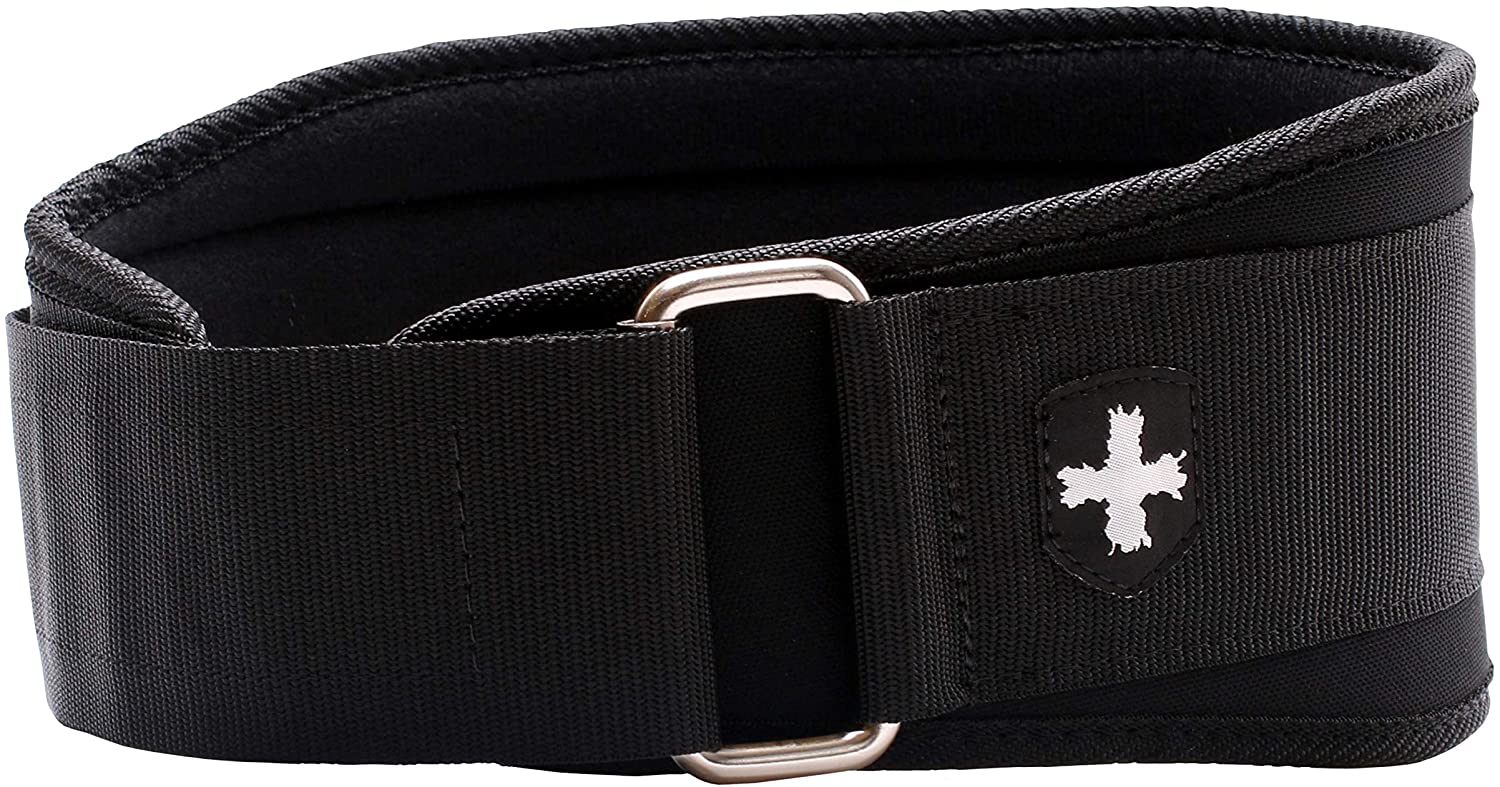
Editor’s Rating:
Quick Facts
- Closure: Velcro
- Material: Nylon
- Width: 5”
- Competition Approved: No
Overview
The Harbinger 5” flexible weightlifting belt is a great place to start when looking for some added back and core support that doesn’t inhibit mobility. The added inch of support this belt has on 4” belts helps to provide more comfortable support that is spread across a larger surface area.
This belt uses a soft, lightweight foam core that provides cushioning and comfort while also providing support to the wearer’s core and spine. The flexible nature of this belt means that it provides less stability overall when compared to firmer belts. This means it’s not ideal for lifting very heavy weights, but it is great for some added support throughout different lifts and maneuvers.
Quality
Made from a sturdy nylon material, the Harbinger 5” flexible weightlifting belt holds up quite well to continued use. The Velcro closure provides strong adhesion initially that provides ample pressure for supporting the lifter’s core and back. However, Velcro does wear out over time and become less adhesive during regular use.
Who It’s Best For
This is an affordable entry-level lifting belt option that is a great choice for people who want some extra support. The Harbinger 5” flexible weightlifting belt is ideal for gym-goers looking to maximize their mobility while still gaining the benefits of having added back and core support provided by lifting belts. This lifting belt is great for beginner lifters that are still working on their form and for Crossfit or other circuit-style training participants.
While the flexibility and light weight of this belt is great for comfort throughout movements, it doesn’t provide as much support as the other belts on our list, nor is it competition approved—making it a sub-optimal choice for people really looking to stack on the plates. However, its affordability, ease of use, and comfort make it a great starter belt for new lifters and for general back/core support during lifts.
- Flexible and lightweight for comfortable support throughout the day
- Inexpensive
- Quality materials and construction
- Good for beginners
- Not competition approved
- Not ideal for powerlifters looking to max out on lifts
8. RDX Powerlifting Belt
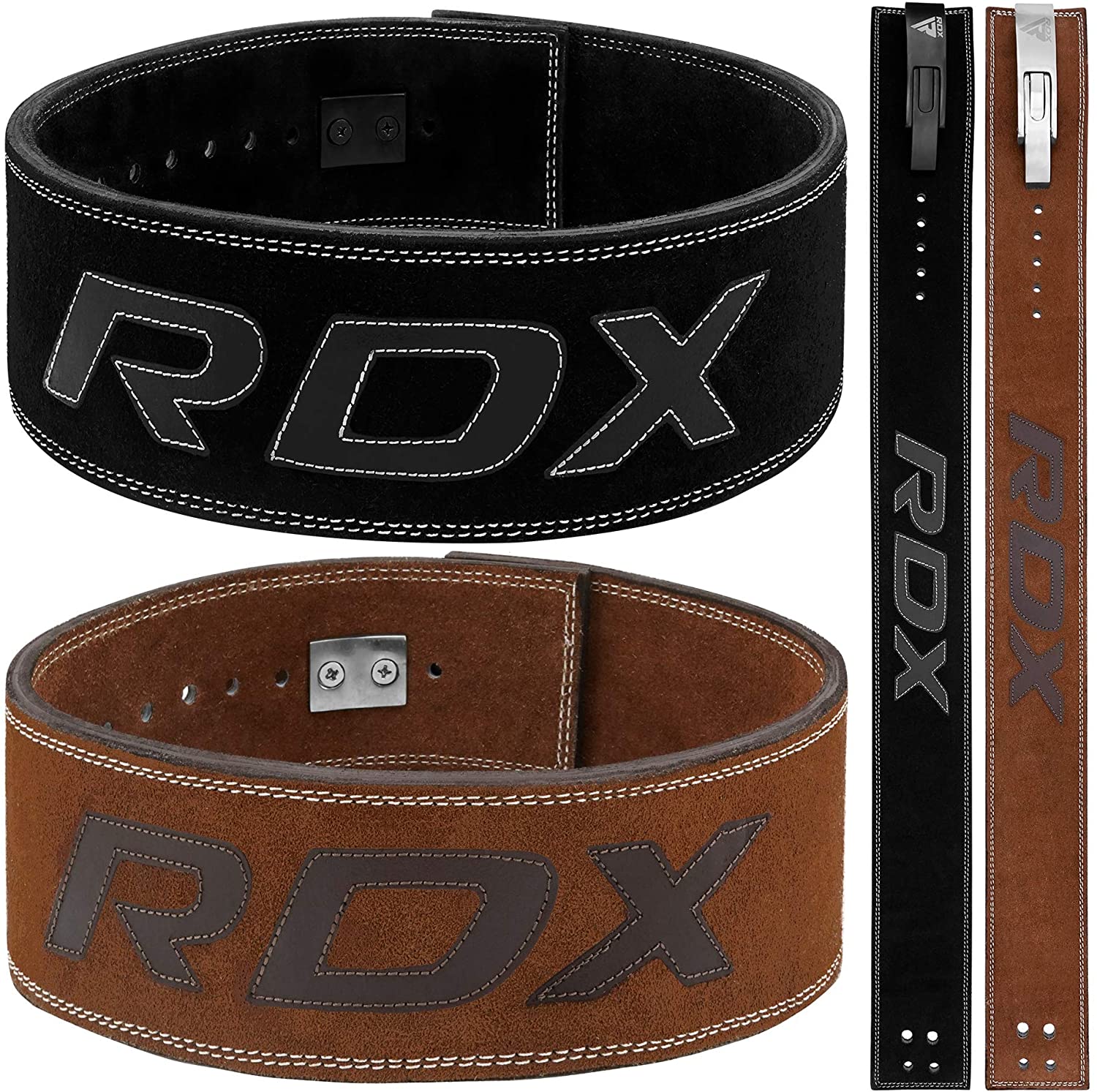
Editor’s Rating:
Quick Facts
- Closure: Lever
- Material: Leather
- Width: 4”
- Competition Approved: Yes
Overview
This is a fantastic no-frills powerlifting belt that is built to last. The RDX powerlifting belt provides superior back and core support thanks to its 10mm thick leather construction. This belt utilizes a lever closure system that provides firm fastening to keep the belt from shifting during your movements. The lever also makes it easy to quickly release tension so you can catch your breath after hitting a big lift.
Quality
RDX uses thick, quality, genuine cowhide leather stitched together with industrial-grade dual stitching to provide an ultra-firm belt for superior support during lifts. The steel lever closure system is rustproof and provides excellent tension. The entire RDX powerlifting belt is built from the ground up to provide serious lifters with everything they need to put up big numbers.
The sturdy construction does mean this belt is rather bulky thanks to its weight and lack of flexibility. This makes the belt ideal for powerlifting, but not so great for general support wear or for circuit-style training that involves more dynamic movements with a higher requirement for mobility.
Who It’s Best For
Thanks to its thick, rugged construction and IPL/USPA approval, the RDX powerlifting belt is ideal for serious lifters who want to train and compete in the same belt. This 10mm thick leather belt is perfect for putting up big numbers and pushing yourself to the limit. Quality like this doesn’t come cheap, but the price is reasonable and the performance provided by this belt is well worth it.
This belt is not ideal for Crossfitters or people who are interested in maximizing their mobility during workouts. The RDX powerlifting belt is purpose-built for helping powerlifters to improve their one-rep maxes.
- Approved for IPL and USPA competitions
- Extra thick, quality leather for superior core and back support
- Steel lever clasp provides quick and firm fastening
- One of the more expensive belts on our list
- Bulky and heavy
9. Most Comfortable Lifting Belt: Steel Sweat Nylon Lifting Belt
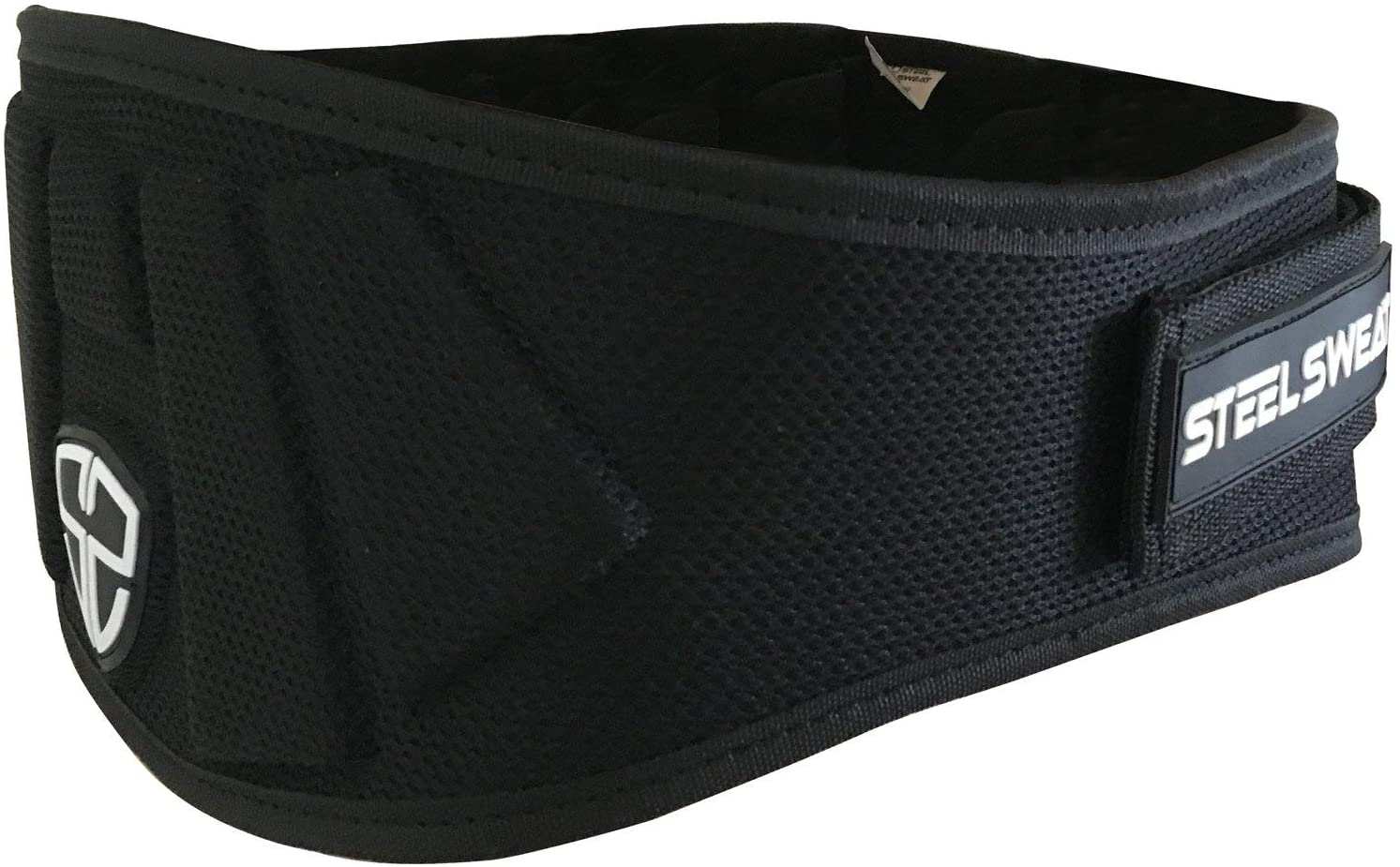
Editor’s Rating:
Quick Facts
- Closure: Velcro
- Material: Nylon
- Width: 6”
- Competition Approved: No
Overview
This Steel Sweat lifting belt was designed with comfort in mind and this belt does an excellent job of providing stability and comfort for wearers looking to improve their spinal health. The tapered and padded design provides solid core support that is extremely comfortable. Thanks to the Velcro closure system this belt can be cinched in to your desired level of compression easily.
Quality
The nylon construction of this belt is sturdy and rugged. It provides excellent compression and stability thanks to its rigid, tapered design that supports the back and core. Unlike most of the other lifting belts on our list, this Steel Sweat nylon lifting belt uses plastic instead of steel for the closure system. This helps keep the cost down, but does make it a little less durable overall.
Who It’s Best For
This belt provides good core and spine support for lifts, but it’s breathable material and padded design makes it ideal for circuit-style training and daily use on the job or at home. This is an inexpensive lifting belt option that provides strong stability and good comfort so you can keep your spine supported all day long.
The lack of competition approval and the overall design of this belt make it a poor choice for strict powerlifting purposes. However, this belt is perfect for people looking to provide their spine with some additional support throughout the day, whether that’s at the gym, on the job, or around the house.
- Lightweight and comfortable
- Inexpensive
- Provides solid core and spine support
- Not ideal for powerlifting
- Not competition approved
10. Harbinger Padded Weightlifting Belt
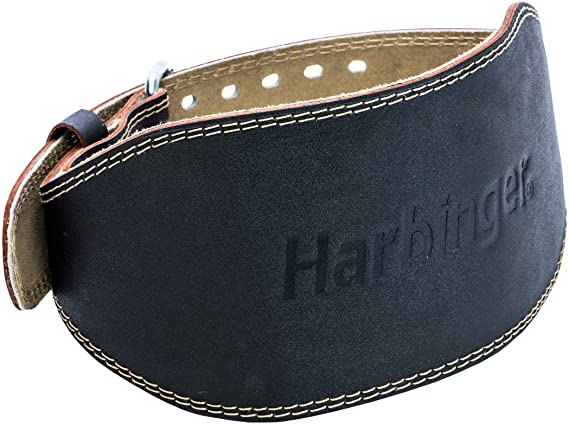
Editor’s Rating:
Quick Facts
- Closure: Two-prong
- Material: Suede lining
- Width: 4” or 6”
- Competition Approved: No
Overview
Built for comfort and performance, the padded Harbinger lifting belt offers a decent helping of both at a reasonable cost. Using a narrow (roughly 2-3 inches) belt that flares out to a wide (4-6 inches depending on style chosen) back support allows this Harbinger lifting belt to provide excellent stability for the back without overly hindering forward leverage motions. The extra padding provides some additional comfort and support during lifts.
The flaring, contoured design of this Harbinger padded lifting belt allows it to offer strong support while keeping its overall profile and weight down. This makes it more portable and more comfortable for those who prefer the contoured style with a narrow band around the front and wide support in the back.
Quality
While this belt does use leather construction, it’s only on the exterior lining while the internal material is made from a foam cushioning. The leather exterior is of solid quality and the double-stitching used throughout holds up well, but the internal cushioning material has been known to break apart. Using a standard two-prong closure system gives lifters decent control over the snugness of their fit, but other closure systems offer more variability and easier tightening.
Who It’s Best For
While not of the highest quality, this belt does provide solid support and comfort throughout lifts at a reasonable price. The padding and contoured design combined with a leather outer material provide a good mix of rigidity and malleability to allow the belt to conform to the lifter well. This belt is priced well for lifters interested in experimenting with different fits and materials, but is a bit too pricey to recommend to beginners.
- Exterior leather lining
- Contoured design for enhanced comfort and portability
- Additional padding with foam cushioning interior
- Known to wear out over time
- Not competition approved
Buying the Best Lifting Belt
As with most products, finding the best lifting belt for your needs is all about understanding what you’re looking for based on your needs. But you can’t know what to look for if you don’t fully understand how the product functions.
In light of this, we’ll cover the basics of lifting belts so you can get a better idea of how they work and what specific aspects are most important to you.
How Do You Use a Lifting Belt?
While it may seem pretty obvious how a belt should be used, lifting belts are considerably more nuanced than typical belts. After all, lifting heavy weights seems fairly straightforward but experienced lifters know there’s a lot more that goes into performing a big lift than is readily obvious.
The first step to properly using a lifting belt is putting it on correctly. Unlike with standard belts, lifting belts aren’t there to keep your pants on. Instead of belting it around your upper hips, lifting belts should be placed right around the waistline, above your hips near your belly button area. When you strap in your lifting belt right before your lift, you should make sure that it’s very tight. Remember, the primary purpose of a lifting belt is to provide your abdominal wall with a surface to press outward against—thus increasing your intra-abdominal pressure (IAP) and providing stability to your spine.
Wait, what’s all this about IAP and pressing out against the belt? If you’re newer to the world of lifting heavy, you are probably going to be confused when you read the words “Valsalva maneuver,” so let’s start there and circle back to using a lifting belt.
The Valsalva maneuver (named after a 17th-century Italian physician) is a breathing technique that is used in the medical world for managing heart rate and blood pressure. Aside from aiding in slowing the heart rate when it becomes erratic, the Valsalva maneuver also increases IAP while it’s being performed.
IAP is pressure that you can build up inside your abdomen. This pressure can be regulated by your breathing and by flexing your abdominal muscles to create a stiff balloon of air inside your body. The Valsalva maneuver is often recommended by doctors of patients that suffer from tachycardia (an abnormally fast heart rate) to help slow down and regulate their heart rhythm.
This maneuver is also known to spike blood pressure. As such, the Valsalva maneuver shouldn’t be performed by people with cardiovascular problems without the supervision of a doctor. However, the vast majority of healthy people can perform the Valsalva maneuver without any harmful or negative effects. The Valsalva maneuver can be performed at any time so go ahead and give this a try right now if you’re up for it so you can better understand the concept.
How to Execute the Valsalva Maneuver
Step 1: Take a big breath deep into your belly, forcing air into your midsection without making your chest rise. Think “breathe down” as shown in this video. The goal is to expand your belly and make it into a tight balloon. You should be able to expand your belly without breathing in, but the cue of “breathing into your belly” helps with creating the initial pressure in the desired location.
Step 2: Press your tongue against the roof of your mouth firmly, closing your glottis while you attempt to exhale against it. The glottis is the opening in your throat that allows air to pass through it. If you’re doing this correctly, you should feel pressure building in your abdomen with some pressure in the back of your throat where you’re clamping down your glottis against your attempts to exhale.
No air should come out during this even if your mouth is open as the glottis is where the air is blocked off when the Valsalva maneuver is executed properly.
Step 3: Flex your core. You want to press your belly out from the inside by combining air pressure and muscle flexion. Basically, act like someone is about to punch you in the stomach and you want your stomach to be as firm as possible right before the hit lands.
Step 4: Maintain a closed glottis and flexed core throughout your lift, releasing the air and breathing normally after you complete the movement. You can maintain the Valsalva maneuver for two to three consecutive reps, but you shouldn’t hold it in so long that you get lightheaded. Starting off doing one rep at a time is a great way to practice the maneuver and focus on each individual rep.
The Valsalva maneuver is done naturally by most people whenever they are preparing to exert a lot of force whether that’s to push a stalled car or pick up something very heavy. This maneuver can be done with or without a lifting belt, but doing this with a belt is how you take advantage of the belt by pressing outward against the belt to increase IAP and spine stability.
The goal when performing most lifts is maintaining a neutral spine and the Valsalva maneuver combined with a lifting belt helps to achieve that in the most effective way possible. There’s a reason why almost every powerlifter can be seen at competitions wearing a lifting belt and turning their face beet red as they execute their lifts.
When Should You Wear a Lifting Belt?
The reality is that a lifting belt is by no means mandatory for putting up big numbers. However, there is strong evidence that supports the idea that lifting belts help lifters to achieve maximal performance.
This study shows that the primary physiological benefit of wearing a lifting belt is the ability to achieve higher levels of IAP when compared to using only the Valsalva maneuver without a belt. This increase in IAP provides core and spine stability that helps reduce exertion when lifting—allowing lifters to achieve higher single rep maximums (1RM) and more repetitions at lower weights.
Lifting belts can also provide psychological benefits that can lead to increased performance. Wearing a lifting belt can increase a lifter’s proprioception which can result in better lifting performance.
Proprioception is a fancy word for talking about your awareness of your own body. Basically, proprioception is our ability to feel or intuit how the different parts of your body are feeling and how everything is relatively positioned. It’s how we can walk down stairs in the dark or understand where we messed up during a deadlift.
Proprioception can be increased through various training methods and it can be increased through the use of exercise equipment or clothing. Compression clothing (which is basically what a lifting belt is) provides more sensory feedback from the compressed parts of our body as we move our body.
So lifting belts do provide various benefits, but they can also have some drawbacks as well. Lifting belts inhibit mobility while they provide your core with something to press outward against. This means that you can become overly reliant on the lifting belt to stabilize your spine and may result in your form becoming worse if used too often. Lifting belts can also cause wearers to have increased levels of confidence and security that can lead to loss of focus or overestimating their capabilities, potentially resulting in injury.
Ultimately, lifting belts are primarily used when performing heavy squats, deadlifts, overhead presses, and Olympic lifts. However, you shouldn’t necessarily wear one every time you’re performing these lifts. Some people like having the comfort of having additional support during their workouts, but trusting completely in your belt to protect your spine is a good way to get injured.
Lifting belts can be worn throughout all of your workouts, but we generally recommend wearing a standard lifting belt when going for heavy sets or when you’re looking to pump out a new PR. However, there are other kinds of lifting belts that are well-suited to practical applications and other types of training aside from powerlifting methods.
Lifting Belt Materials
As we mentioned earlier, lifting belts essentially come in one of two materials: leather or nylon. Leather is the de facto standard choice for powerlifters looking to hit big numbers. Nylon, on the other hand, offers several benefits over leather for lifters who are more concerned about mobility and maintaining a quicker pace through their workout. Here is a breakdown on each material’s advantages and disadvantages.
Leather Lifting Belts
Leather is the go-to material for the standard lifting belt design because of its rigid yet supple nature.
Advantages of Leather
Thick leather lifting belts provide a very firm and stable surface that you can use to maximize your IAP through the Valsalva maneuver. The leather provides enough flexion to be comfortable without compromising on stability for your spine. Quality leather can also last for a lifetime.
Disadvantages of Leather
Leather lifting belts are quite heavy and very bulky. This makes them a bit of a pain to transport back and forth from the gym and it causes them to more quickly fatigue the lifter compared to a lighter option or no belt at all. Leather lifting belts are also restrictive and can inhibit mobility. Typically, leather lifting belts are tightened immediately before performing a lift or set and then are loosened or removed entirely afterwards to allow for normal breathing to resume.
Nylon Lifting Belts
Nylon is an inexpensive and slightly flexible material frequently used as an inexpensive, comfortable, and wicking belt material.
Advantages of Nylon
Nylon lifting belts are lightweight and rugged. They offer good proprioceptive feedback without being overly restrictive. Movement is much less encumbered when wearing a nylon lifting belt compared to a leather one. This makes nylon lifting belts an excellent choice for people who do crossfit or circuit-style training. Nylon lifting belts can have their tightness adjusted more easily and are often comfortable enough to leave on throughout your workout. Nylon is also commonly used in other weightlifting support applications, especially for knee compression sleeves.
Advantages of Leather
Nylon’s flexibility is a boon and a curse. Due to how flexible it is, nylon provides much less support compared to leather lifting belts. This impacts how much IAP you can build up using the belt, which means less support for your spine and lower maximal output for heavy lifts.
Generally, nylon lifting belts like the Element 26 lifting belt are recommended for functional and circuit-style workouts while leather belts like the Dark Iron Fitness lifting belt are the go-to choice for people who want to max out on their lifts.
Lifting Accessories
A lifting belt isn’t the only weightlifting accessory that will improve form, reduce injury, and raise your PRs. Consider the following accessories for a great weightlifting experience.
- Deadlift Shoes: A pair of deadlift shoes improves form and reduces the risk of injury, not only on deadlifts but on other on-foot lifts as well. You can take a look at our favorite deadlift shoes here.
- Workout Gloves: Supporting your wrists and fingers instead of your core, workout gloves are just as important as a lifting belt on heavy lifts. Some of our top picks can be found here.
- Compression Shorts: Gym goers quickly realize that traditional cotton boxers just don’t cut it when you’re lifting. Check out a list of our favorite compression shorts here.
Lifting Belt Closure Systems
Much like with the materials that lifting belts use, there are only a few kinds of closure systems. Each offers its own advantages and disadvantages. Lifting belts come in three primary types of closure systems: 1, 2, or 3-pronged; Velcro; and lever style.
Pronged Closure System
Pronged closure systems work like a standard belt with holes punched into the belt in even intervals where the prongs are inserted to hold the belt in place. This system is inexpensive and easy to use; however, it doesn’t allow for granular dialing-in of the fit as you can only use the pre-drilled holes.
Velcro Closure System
Velcro closure systems are the epitome of easy-to-use. Velcro also offers the benefit of granular fitting that allows you to find the perfect tightness for your lifting belt. On the downside, Velcro wears out over time and can lose its adhesive power. Lower quality Velcro can also separate when enough pressure is exerted on the belt, like in the bottom of a squat—potentially causing the belt to pop open and loosen. The chances of this happening grow as the Velcro ages and becomes less adhesive.
Lever Closure System
Lever closure systems are the quickest and easiest when it comes to snapping the belt on right before a lift and loosening it when you’re done. Levers allow for you to get a really tight fit that is exactly the same from one day to the next. On the downside, lever closure systems take longer to modify if you want to change how tight the belt is from one lift to another like when switching between squat and deadlift, for instance.
Ultimately, the closure system that’s best for you is a matter of preference. Typically, you’ll only find Velcro closure systems on nylon belts and you’ll only find pronged closure systems on leather belts while both leather and nylon have lever closure systems. Finding the right style of belt and closure system for you is about balancing your needs for comfort and performance.
Lifting Belt Comfort vs. Performance
There are several factors that will impact your overall comfort and performance when wearing a lifting belt. Choosing the right material and closure system that is best suited to how you work out is the only way to find one that checks off all your boxes. In general, leather is best if you are a powerlifter, while nylon is likely to be more appreciated by circuit-style trainers that need the increased mobility and lighter weight.
In general terms, lifting belts aren’t very comfortable. When worn for maxing out on lifts, they should be uncomfortably tight to the point that you can sometimes see bruising afterwards. Powerlifters are no strangers to bruising, so this shouldn’t come as too much of a shock. While belts should be worn tightly, they still need to fit properly.
How to Find the Right Lifting Belt Size
Unlike standard belts, lifting belts aren’t designed to be worn where your pants sit. This means the sizing for them is different from standard belts as well. With lifting belts, you don’t go by your pant size but instead you measure around your waist, near the navel area, where the belt should be worn.
When measuring, make sure you breathe naturally and don’t hold the tape too tightly. Lifting belts are given sizes like XS, XL, etc. These sizes can vary from one manufacturer to the next, but pretty much every lifting belt manufacturer includes recommended waist measurement ranges for each belt size. So measure twice, check the comments to see if people complain about sizing issues, and buy once with confidence.
Bottom Line
Competitive powerlifters and gym goers looking to maximize their lifting potential can realize increased output when using lifting belts properly. Lifting belts shouldn’t be treated as a form of protection for your back but instead should be thought of as a tool for improving your lifting technique. Getting the most out of a lifting belt requires training and practice, but a good lifting belt can absolutely help you set new personal bests in the gym. Good luck and stay strong!
